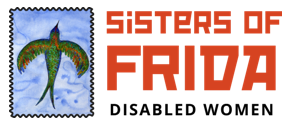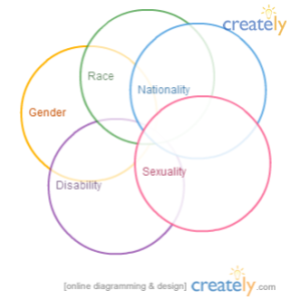

Bringing disabled women together, mobilising
and sharing through lived experiences
UK CEDAW Working Group submission to CRPD general discussion on women and girls with disabilities
(the deadline has been extended to 31st March)
Below is a submission from the UK CEDAW Working Group on behalf of Sisters of Frida for the CRPD general discussion on women and girls with disabilities on April 17th 2013. (with thanks to Charlotte Gage for getting it out in time)
Introduction
Most States lack a specific and comprehensive law, policy or programme on persons with disabilities in general or on women with disabilities in particular. States that do have a disability law often do not specifically address the rights of women with disabilities. States may also have a specific law on violence against women that generally provides remedies for all women, within a non-discriminatory framework, but unfortunately, such laws are not effectively implemented in respect of women with disabilities. Very few States have established dedicated institutional mechanisms, programmes or strategies such as national committees or councils on women and disabilities.The United Kingdom (UK) is no exception.
The UK says that it uses the social model of disability which recognises that disability arises from society’s negative responses to us, inaccessible environments, discrimination and disablism. However, the UK definition of disability is not compliant with the CRPD. Disability is not an inevitable consequence of impairments and equality is possible and can be achieved through removing the barriers to social inclusion. This report demonstrates that the statistics fail to recognise that disabled people are not a homogenous group and include disabled women as well as men. This is partly due to a general lack of data disaggregated from a gender and disability perspective. Disabled women‚Äôs needs are often excluded in the mainstream Disability Movement as well as the Women‚Äôs Movement, and wider government policy, which explains the lack of both qualitative and quantitative data specifically about disabled women in all the areas discussed below. Disabled women often remain invisible in mainstream legislation/policy for women and disabled women‚Äôs issues are still under-researched, and their concerns are overlooked….
Download the whole report (MS Word doc):
 UK CEDAW Working Group submission_disabled women_2013
note: We would like to acknowledge contributions to this report from Armineh Soorenian, Debbie Jolly, Eleanor Firman, Ellen Clifford, and Eleanor Lisney
Sisters of Frida’s Anne Pridmore takes on Government
We at Sisters of Frida are proud to support Ann Pridmore, from Sisters of Frida, a disabled rights campaigner as she prepares for one of her toughest fights in taking on the Government in court.
Anne will be one of six disabled people from across England challenging the decision to scrap the independent living fund (ILF).
The cash can be used for such things as hiring an assistant and getting laundry and shopping done ‚Äď which are not provided by councils through social services care packages.
The fund has already closed to new members and, from 2015, the money will go to councils instead.
It will not be ring-fenced, meaning local authorities can do what they want with it.
Anne, of Market Harborough, said she feared many disabled people would have to rely on relatives or charities in order to continue living independently. Her challenge will be heard at the High Court in London over two days from March 13.
Anne, who has been campaigning for disabled people’s rights for 27 years, said:
“The Government always attacks the weakest members of society. There are about 18,500 people who are at risk of losing their funding and it’s a big step backwards.
“This Government has set back disabled rights 25 years since it has been in power, with people being taken off incapacity benefits and now this.
“It’s undoing all the work I’ve been doing.
“I think this fight is going to be a hard one.”
Anne said while she felt too old to be taking a Government department to court, she was doing it on behalf of younger people with disabilities who could benefit from the ILF in the future.
The six disabled people will ask the courts to declare that the public consultation held last year was unlawful and that the department had failed to explain why the only option it offered in its consultation was to close the fund.
They will also argue the Government breached the Equality Act by failing to assess the impact of the closure on disabled people.
Read more: http://www.thisisleicestershire.co.uk/Anne-takes-Government/story-18134803-detail/story.html#axzz2LpItqwMH
What Is “Intersectional” Anyway?
Many thanks to Emma @pseudodeviant for letting us repost this blog.

Emma with SoF 2012 at MWR
I imagine that if you are reading this you¬†identify¬†either as a feminist, a disabled person* or as an ally of feminists and/or disabled people and you might have heard the term “intersectional” or “intersectionality” used when talking about peoples rights. It might sound a bit academic, but the principle is fairly simple and¬†extremely¬†important so I’m going to attempt to explain it in this post.
In a nutshell: 
People are oppressed for a¬†variety¬†of different reasons such as disability, gender, culture, sexuality & race. There is a lot of overlap between these oppressions; we call the areas of overlap intersections. Someone who campaigns for disabled peoples’ rights in an intersectional way is aware that there are lots of disabled people who are not heterosexual, cisgendered, white men and that they will probably be living with more than one kind of oppression. Many people, myself included, believe that it is very important to¬†remember¬†intersecting oppressions to make sure that our¬†campaigning¬†is as inclusive of everybody’s needs as possible.

A very simple venn diagram showing some intersecting circles of oppression including gender, disability, sexuality, nationality & race.
If you are a disabled person or an ally to disabled people I assume you will be no stranger to the idea that our society is, at it’s core, disablist. The majority of people in positions of power are non-disabled and this is in a large part because disabled people are still routinely silenced, dismissed, ignored or refused access to the¬†necessary¬†tools to be able to communicate meaningfully. They are frequently¬†excluded¬†from politics, from¬†decision¬†making and from society as a whole because of damaging and deep seated idea’s about what disability is or means. It results in a large gap in pay, employment prospects, education, access to health care and access to independent living between disabled and non-disabled people. The power gap between disabled and non-disabled people is frequently abused and results in disability related hate-crime, abuse & harassment whilst the¬†successful¬†prosecution of such crimes remains woefully low.
If you are a feminist or an ally to feminists then I assume you will be no stranger to the concept that our society is still very sexist. The majority of people in positions of power are male and they decide what media we consume, what policies we follow and how our laws are applied. Sexist stereotypes brand men as strong, powerful, aggressive, logical and confident and women as weak, passive, caring, guided by emotion and small and they have damaging effects on men & women alike who do not fit those very constraining moulds. There is a large gap in pay, caring expectations, attainment and employment & educational choices between women and men. The power gap between men and women is frequently abused and results in statistics like 1 in 4 women being domestically abused in their lifetime, 1 in 5 women being sexually assaulted or stalked whilst the chances of getting these crimes taken to court is still low.
I would hope that it doesn’t come as a shock when I now say that as well as people being discriminated against because of their gender/gender identity (or¬†perceived¬†gender) or because they are disabled (or¬†perceived¬†to be disabled) are also discriminated against in remarkably¬†similar¬†ways because of their race (or¬†perceived¬†race), age (or¬†perceived¬†age), sexuality (or¬†perceived¬†sexuality) and beliefs (or¬†perceived¬†beliefs).
We can also see that where there is an overlap of identities (or an intersection of identities) people face extra discrimination. I will take the example of disabled women quickly to illustrate this point. Disabled men get paid on average 11% less than similarly qualified non-disabled men doing the same job. Disabled women get paid 22% less than disabled men when doing the same job**. They effectively take one pay cut because of disability, then another because of gender. Disabled women are more than twice as likely to experience domestic/intimate abuse than non-disabled women.
When human/civil rights¬†campaigners¬†talk about taking an intersectional approach they are talking about¬†remembering¬†that there are other forms of oppression active and that these need to be taken into account. It is important to¬†remember¬†that when talking about¬†women’s¬†rights that many of those women will also be one or more of the following; disabled, working-class, black or minority ethnic (BME), lesbian, gay, bisexual, trans*, intersex, queer (LGBTIQ) and/or hold cultural & religious beliefs that differ to the ‘norm’. When women’s rights campaigning ignores those areas it is complicit in further marginalising these women on the basis of their other¬†characteristics.
Intersectionality is not about who wins the “most oppressed” award, nor is it about derailing or silencing conversations. The joy of intersectionality is that it¬†raises¬†questions for everyone and widens the scope of conversation, debate and dialogue. It is a tool which can be used to improve campaigns, make for a far more inclusive¬†environment¬†and to remind people not to assume that everyone has an equal and shared background. I don’t know about you but I personally don’t¬†want¬†to see advances in feminism that set LGBTIQ people back in¬†their¬†fight for equality and nor do I want to see advances in disability rights that ignore the reality of sexism that the people it represents experience.
I’m going to stop there. Hopefully that has given a basic introduction to the concept and hopefully it will have made some sense.
* In this post when I talk about disability I am talking about people who have an impairment and are disabled by a society that oppresses them as a result. My definition of disability includes long term sickness/illness and conditions like HIV.
** See Longhi,S. and Platt, L. 2008, Pay and equalities areas. Research report 9. Equality and Human Rights Commission. Also covers pay gaps with regards to other protected characteristics.

